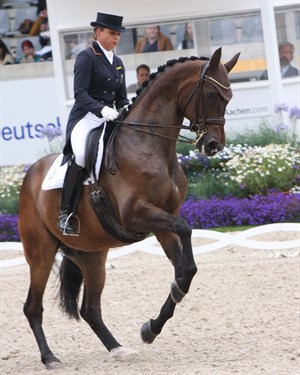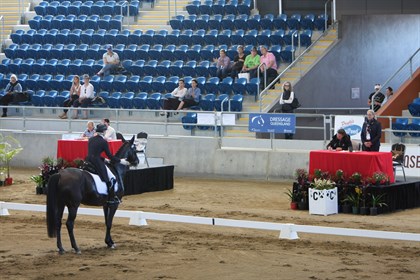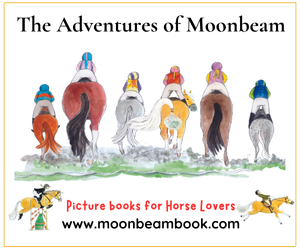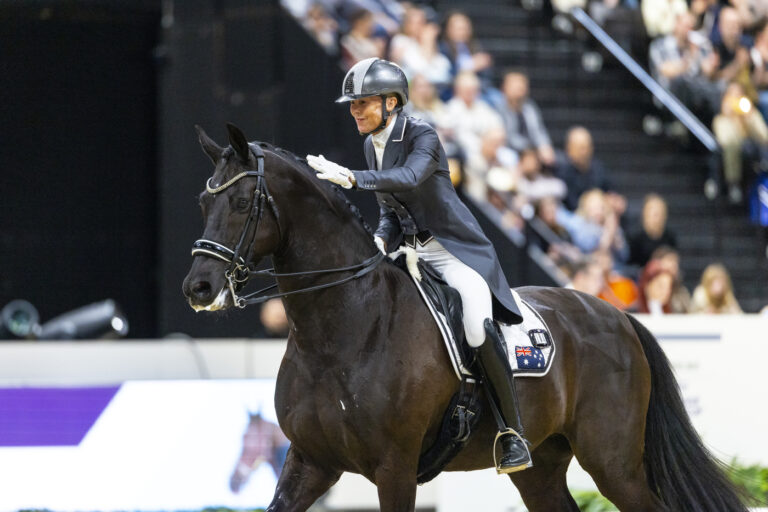This article has appeared previously with Equestrian Life. To see what’s in our latest issue, click here

Dorothee Schneider rides under the watchful eye of the judges.
© Roger Fitzhardinge
By Roger Fitzhardinge
The judge’s opinion is very influential on the direction in which the sport of dressage progresses. Riders, coaches, breeders and owners all want their team to win. If the judges decide they want necks high, that’s what riders do. If they want them really forward or very collected, or relaxed or very expressive, then that is the way the coaches will train the horses and riders to fulfil what the judges want so they can win.
When you think about the power and responsibility that a dressage judge holds through their expert educated opinion, it can be worth thousands of dollars, perhaps hundreds of thousands, in relation to the value of a horse — let alone the rise to fame of a rider, horse or trainer, their future and their ability to promote and run their businesses. The judges certainly have a lot of influence; they could easily turn competitors away from the sport if they use negative comments constantly, even if the intention is positive, as riders have great empathy and care for their horse no matter how great or how insignificant on the competition scale these comments are. The sport encourages everyone to assess when the training is on the correct way and I believe that to be helpful, the judge’s attention should be on what is correct and expand on this positively — not negatively where every positive comment is finished with “but…”. Judges also need to tread carefully when being asked to talk about the young horse class in front of the rider and the crowd and only those judges who are most experienced should be invited to do so.
FEI 5* dressage judge Mary Seefried watches competitiors at the Brisbane CDI
© Roger Fitzhardinge
Judges should perform their educated expert job and comment on what they see — that’s judging! It’s not their position to wear the trainer’s hat and give the riders a lesson or a training lecture. They should comment on the way the horse achieved marks and what could be done better to achieve higher marks. Leave it at that. You don’t ask the plumber about the electrical wiring to the computer; this is akin to the dressage judge giving a training lecture when they are judging.
Judges are well respected and take their work very seriously, and the Equestrian Australia judges’ education scheme requires that they are refreshed continuously. Of course the sport and judging is subjective, and as a consequence difference of opinions do happen, some because of the position in which the judge sits. Needless to say, with continued education, regular judging and through confidence, a judge’s opinion and ability to remain unbiased and true to what they see at each movement and moment (rather than be influenced by history and past performance) grows. This honest and unbiased appraisal of each movement as it happens, with no thought other than at that moment, is the sign of a good judge. All the same, judges (in a similar way to riders) need to be open to continuous improvement and opinions and be always looking to learn, as it’s a sport that is fascinating, fabulous and beautiful — yet complicated and difficult at the same time!
NO ROOM FOR IMAGINATION
For riders and judges alike, they should realise there are going to be different percentages for the same horse from judges on the same test. This should not be discouraged — otherwise mediocrity will step in. If judges are criticised for voicing their opinion, then they will become cautious to mark as they see for fear of stepping out of line. Boring, middle-of-the-road percentages will follow!
At national competitions there are two or three judges (sometimes five), and at big international championships there are seven. Their purpose and contribution to each horse and rider’s performance needs to be very well understood. The judges at the various points around the arena give input as to what they see and mark according to what their position is expected to look for. No one judge can take credit for the overall mark; it’s the combined average of all the marks from all judges that determines the final mark. Each judge has a specific job to look for and should not be concerned at what the other positions are doing. If you can’t see it, it’s not there. Imagination has no bearing on the mark, nor does the prior performances or expectancy of any horse or rider.
If cameras were placed at the marked positions and the footage from each was judged marking only by what you see on the individual camera clip, then when you plug all the marks in from all the views you would get a great overall mark, and each judge should not be concerned with being high or low if that’s what they see from their position. It would be useful however if the side judges were in agreement because they mostly see the same thing. It is possible to give a 5 and an 8 for the same movement, and both judges can be right as to what they see from the specific place they are seated. For example, a halt at X where the long side judges give a 5 and the short side judges give a 7 or 8. The average is then the correct mark. Therefore, the more judges and the more input from all angles, the more accurate the overall percentage.

The final halt in front of the judge at C.
© Roger Fitzhardinge
It’s like X-raying a horse’s joint: one angle may show a joint to be normal, while two angles could show different things. The more angles, the better the overall picture. As with an X-ray, what a judge sees from the side view and front view are obviously quite different, and the comments and marks will be quite different. For example, imagine two vets and X-rays of a joint from differing angles, with the vets given just one X-ray each. The views are totally different and they could only comment on the view that’s in front of them.
What is confusing and frustrating for a rider is to read comments that are not pertinent to a judge’s position. For example, a judge on the long side watching a shoulder-in on the side opposite to them may not see the angle, as they don’t have a good view of this. Leave it to the judge(s) that can see. For a horse that shows absolutely no angle, the judge directly in front must be strong in their low mark and deliver an appropriate comment pertaining to what they see in terms of angle, as they are the best placed to see it. The judge on the long side, away from the movement, will know their colleague has that angle covered, and although their opinion may be the horse lacks angle, they can’t be sure about it and so rely on their co-judge on the centreline for that comment. Instead, the judge on the long side would comment regarding the activity/inactivity of the hindlegs, and whether the movement was on the forehand or showed an uphill tendency and good engagement — that is important to mention from their position. In a similar vein, the judge behind the horse in an extended canter on the long side shouldn’t comment on the frame, as they can’t see the shoulders and the neck!
This is why the judging panel acts as a cohesive and respectful team that works together to give a well-rounded assessment. They all need to give their input as to what they see so that a good and fair overall impression and mark can be achieved. The bigger the team of judges, the more likely it is to deliver an accurate assessment.
DIFFERENT VIEWPOINT
Looking at percentages and placings from the judges, it must be emphasised that the marks may differ for the judges on the long sides compared to those on the short side. Good judging could see marks and placings like this:
E 60% 5th
H 65% 1st
C 66% 1st
M 64% 1st
B 60% 5th
The HCM judges look straight at the horse with slight variances, while the BE judges see the side profile. So the long side judges should be similar and the short side ones similar, with minor variations. As the standard increases, and as seen at Olympics, the variance between the judges is reduced and the placings from all the judges are more aligned.
Below are some ideas regarding aspects judges should assess from their positions. It’s not obsessing over the minor problems, but about keeping the whole horse in mind as it’s the harmony, balance and total impression — and ways to make the complete picture more impressive — that need the judges’ attention.
C JUDGE
The C judge is in charge of course errors, elimination for bleeding and any eliminations for other reasons. Head of the jury, they get a very good overall impression, but primarily look at basics such as:
• Straightness.
• Regularity.
• Bend and flexion and the equality of this on each rein in the lateral work and the corners.
• Fluency of the test.
• Overall impression of balance and way the movements are put together.
• Ease of the movements and the uphill tendency and lightness of the forehand.
• Self-carriage.
E OR B (LONG SIDE) JUDGE
Their main perspective is the balance and the frame, and overall shape and consistency. They have the best view of the overall longitudinal frame and the uphill lightness of the forehand.
• Engagement and sitting.
• Regularity of the steps.
• Uphill way of going.
• Balance in the medium and extended paces, the over-track and the uphill tendency and its maintenance.
• The transitions within the pace to see the engagement and lightness and the sitting.
• Bend and self-carriage, in particular movements such as 8 metre circles in Prix St Georges.
M OR H (SHORT SIDE) JUDGE
These judges are primarily concerned with:
• The straightness on the long side.
• Regularity.
• The angles and positioning for the lateral work.
• The overall impression of the balance and ease.
• The straightness in the flying changes and the diagonal lines.
THANKLESS BUT IMPORTANT
Judging is a thankless task, but without constructive and honest feedback from the judges there is no way for improvement in the sport. Riders spend hours every day with their dressage horses and not a day goes by when they are not committed to their cause. No matter how good or how modest any horse and rider is in the eyes of the competition, it’s important that the judges mark fairly and honestly. No rider will begrudge the honest truth, but riders will always compare their marks and placing to the percentages and placings of horses they recognise and know — so the final order is of the utmost importance. Judges, for sure, spend a lot of time watching, reading, learning and ever improving their ability to put appropriate scores to all movements. In fact, our judge accreditation system in Australia delivers world’s best practice in educating and accrediting judges and requires continuous education to remain current and accredited.
Through this continued conscientious attitude the sport will grow, and with it the respect between riders and judges, and judges and riders. It is of the utmost importance that judges understand the significance of their role in the ongoing development and health of the sport at all levels. They have a strong influence on the development of the sport and can never be complacent, but must keep up with their education and positive attitude to move riders and the sport forward.
READ THE LATEST NEWS ARTICLES HERE








